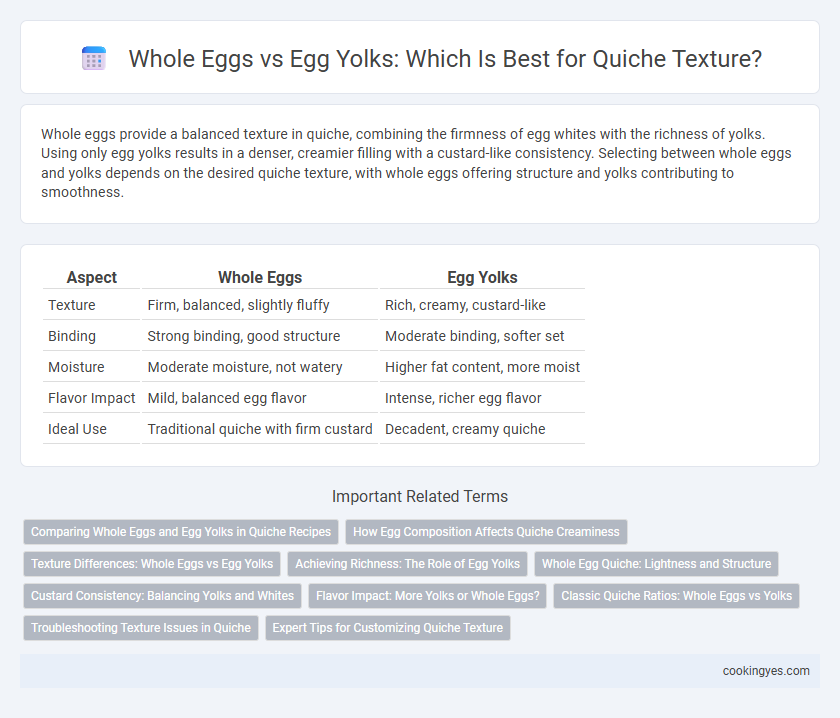Whole eggs provide a balanced texture in quiche, combining the firmness of egg whites with the richness of yolks. Using only egg yolks results in a denser, creamier filling with a custard-like consistency. Selecting between whole eggs and yolks depends on the desired quiche texture, with whole eggs offering structure and yolks contributing to smoothness.
Table of Comparison
| Aspect | Whole Eggs | Egg Yolks |
|---|---|---|
| Texture | Firm, balanced, slightly fluffy | Rich, creamy, custard-like |
| Binding | Strong binding, good structure | Moderate binding, softer set |
| Moisture | Moderate moisture, not watery | Higher fat content, more moist |
| Flavor Impact | Mild, balanced egg flavor | Intense, richer egg flavor |
| Ideal Use | Traditional quiche with firm custard | Decadent, creamy quiche |
Comparing Whole Eggs and Egg Yolks in Quiche Recipes
Whole eggs contribute to a lighter, more custard-like texture in quiche, balancing firmness and creaminess due to the albumen's coagulation properties. Egg yolks, rich in fats and emulsifiers, create a denser, richer texture with a silkier mouthfeel, enhancing the quiche's overall richness. Recipes relying more on whole eggs yield a fluffier quiche, whereas those with higher yolk ratios favor a creamy, velvety consistency.
How Egg Composition Affects Quiche Creaminess
Whole eggs contribute to a balanced texture in quiche by providing both structure from egg whites and richness from yolks. Egg yolks increase creaminess and density due to their higher fat and lecithin content, resulting in a custard with a silky, smooth mouthfeel. Adjusting the ratio of whole eggs to yolks directly impacts the quiche's firmness and creaminess, allowing for tailored texture profiles.
Texture Differences: Whole Eggs vs Egg Yolks
Using whole eggs in quiche results in a firmer, more structured texture due to the combined proteins in both yolks and whites that coagulate during baking. Egg yolks alone create a richer, creamier, and denser custard because of their higher fat content and emulsifying properties. For a silky, tender quiche texture, a higher ratio of yolks to whole eggs is often preferred by chefs seeking smoothness and depth in flavor.
Achieving Richness: The Role of Egg Yolks
Egg yolks play a crucial role in achieving a rich, creamy texture in quiche by providing essential fats and emulsifiers that bind ingredients smoothly. Whole eggs contribute structure and firmness, but the higher fat content in yolks intensifies creaminess and depth of flavor. Using a higher yolk-to-white ratio enhances the custard's silkiness, resulting in a more decadent and velvety quiche filling.
Whole Egg Quiche: Lightness and Structure
Whole egg quiche offers a perfect balance of lightness and structure by combining the firmness of egg whites with the richness of yolks. The protein in egg whites provides a stable, airy texture, while the yolks add creaminess and flavor, resulting in a custard that is both tender and resilient. This balance ensures a quiche that holds its shape well while remaining delicate on the palate.
Custard Consistency: Balancing Yolks and Whites
Using whole eggs in quiche creates a firmer custard with a balanced texture, while relying on egg yolks alone results in a richer, creamier consistency due to higher fat content. A mixture of yolks and whites is crucial for achieving the ideal custard balance--providing structure from the whites and silkiness from the yolks. Optimal ratios, typically two whole eggs with one additional yolk per six-inch quiche, ensure a smooth, tender filling without being overly dense or runny.
Flavor Impact: More Yolks or Whole Eggs?
Quiche texture and flavor vary significantly depending on the ratio of whole eggs to egg yolks used. Whole eggs provide a balanced structure with a lighter texture, while egg yolks contribute a richer, creamier consistency due to their higher fat content. Increasing yolks enhances the quiche's flavor depth and silky mouthfeel, making it more indulgent and luxurious.
Classic Quiche Ratios: Whole Eggs vs Yolks
Classic quiche recipes typically call for a balanced ratio of whole eggs to egg yolks to achieve a creamy yet firm texture, often using three whole eggs combined with one or two yolks per nine-inch pie. Whole eggs provide structure and lift, while yolks add richness and smoothness, resulting in a custard that holds its shape without becoming rubbery. Adjusting the ratio influences the final texture: more yolks yield a silkier quiche, whereas increasing whole eggs produces a slightly denser and more set filling.
Troubleshooting Texture Issues in Quiche
Whole eggs provide a balanced structure and creamy texture in quiche, while egg yolks add richness and a tender, custard-like consistency. Using too many egg yolks can lead to a denser, overly rich quiche that may curdle or become grainy. Troubleshooting texture issues involves adjusting the whole egg-to-yolk ratio and gently whisking to prevent over-beating and ensure a smooth, silky custard.
Expert Tips for Customizing Quiche Texture
Using whole eggs in quiche results in a firmer, more custard-like texture due to the combined protein and fat content. Incorporating only egg yolks increases richness and creaminess, producing a silkier, denser filling without the firmness provided by egg whites. Expert tips recommend adjusting the ratio of whole eggs to yolks based on desired texture, balancing moisture retention and structural integrity for a perfectly customized quiche.
Whole eggs vs egg yolks for quiche texture Infographic

 cookingyes.com
cookingyes.com